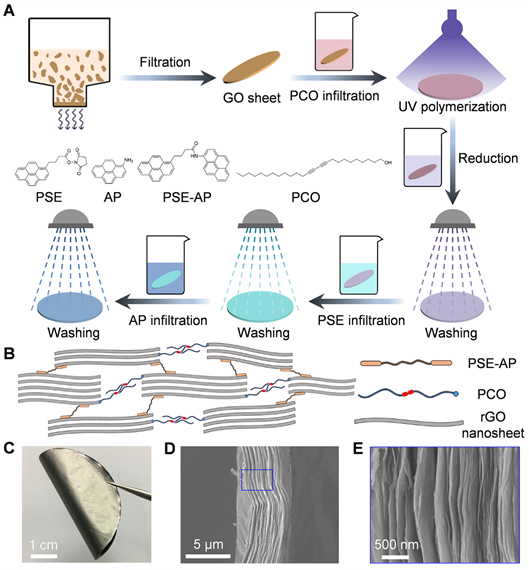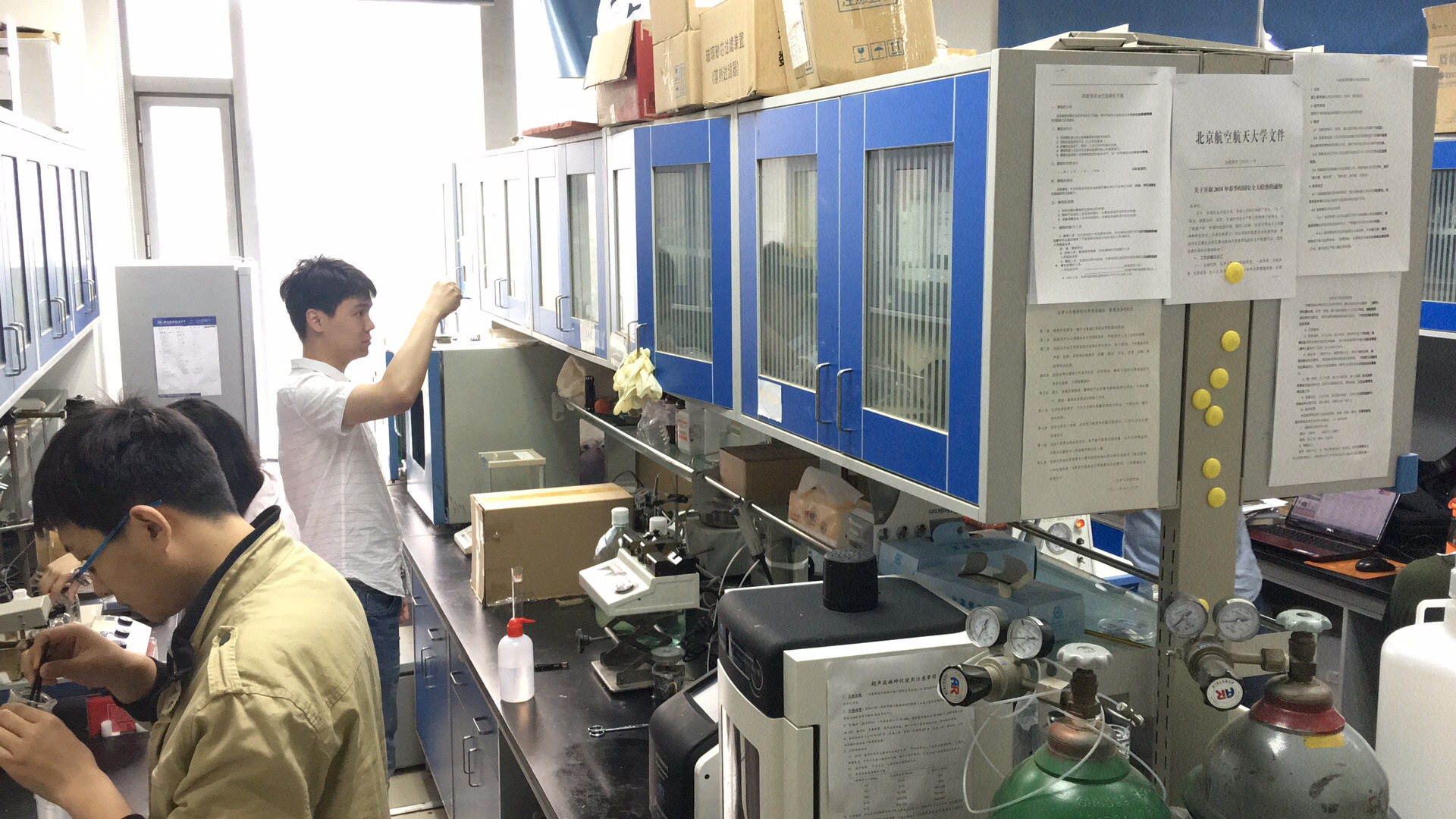On 7th May 2018, Proceedings of the National Academy of Sciences of the United States of America (PNAS) published online the latest research results made by the team led by Prof. Cheng Qunfeng and Academician Jiang Lei from the School of Chemistry of Beihang University under the title of “Sequentially bridged graphene sheets with high strength, toughness, and electrical conductivity”. The corresponding authors of the paper are Prof. Cheng Qunfeng and Prof. Ray H. Baughman, Academician of the National Academy of Engineering as well as Chief Scientist of Beijing Advanced Innovation Center for Biomedical Engineering. The first author is Wan Sijie, a direct PhD student of Beihang University enrolled in 2014.
Background: A New Era of Material Applications
In 2004, Prof. Andre Geim and Prof. Konstantin Sergeevich from the University of Manchester discovered graphene, the thinnest and strongest material in the world. Their extraordinary achievements in the study of graphene won them the Nobel Prize in Physics six years later. Since then, the study of graphene has become a hot topic in scientific researches.
Since 2010, Prof. Cheng Qunfeng and his team have focused on this field. Considering characteristics of the school and the university and aiming to lead the research in this direction, they conceived the idea of applying the new light strong materials in the field of aerospace. They considered the study of the new graphene materials as a promising choice reflecting strategic foresight, as the properties of graphene materials could satisfy the requirements of next-generation unmanned aerial vehicles (UAVs) and light aeroplanes.
Since then, the team led by Prof. Cheng Qunfeng have devoted themselves to the study of multifunctional biomimetic graphene-based nanocomposites and achieved a series of original research results. The fabrication of traditional carbon fiber composites requires high temperature and high pressure, while the new materials can be processed at room temperature (below 45℃). The new materials whose strength is comparable to that of carbon fiber composites have lower cost and are easier to be produced in large scale for commercial use.
Biomimetics: Inspired by the Mollusca Shell
Nature is the most ingenious and imaginative engineer. Biological structures created by nature can offer inspirations for the invention of new materials. Among numerous biological structures that can be imitated to solve human problems, abalone shells draw the attention of the team for its distinctive structure and good mechanical properties. Natural abalone shells are colorful because of their hierarchical structure, which is alternately layered by inorganic calcium carbonate “tiles” and organic protein “adhesive”. The layered hierarchical nano-/microscale structure of the abalone shell results in not only the beautiful outlook but also the excellent mechanical properties, dramatically improving and perfectly integrating mechanical strength and toughness.
Inspired by the organic-inorganic layered nano-/microscale structure of abalone shells, the team fabricated layered composites with graphene oxide and organic molecules. The graphene oxide can be prepared by treating graphite powders (natural minerals) with a chemical approach and the cost is very low.
Based on the study of biomimetic interfacial assembly in previous researches, the team further developed the method of the sequential bridging of π–π bonding and covalent bonding at room temperature, which offered important theoretical guidance to the fabrication of high-performance graphene nanocomposites. Moreover, not only is the tensile strength of the graphene sheets comparable to that of the commercially available carbon fiber composites which have higher costs, but also the toughness of these composites is much higher than that of the latter. Meanwhile, the graphene sheets, containing the sequential bridging of π–π bonding and covalent bonding, have high electrical conductivity, electromagnetic interference (EMI) shielding efficiency, corrosion resistance and fatigue resistance. The high-performance sequentially bridged graphene (SBG) nanocomposites, which have low costs and are processable at low temperature, can be widely used in aviation, aerospace, automotive industry, flexible electronic devices and so on.

Fig.1 Fabrication of SBG sheets (A-B). An SBG sheet (C). The edge of a fractured SBG sheet (D-E)

Fig. 2 Representative stress-strain curve for SBG sheets (A). EMI shielding effectiveness of SBG sheets(B). Dependence of Raman frequency down-shifts on applied strain (C-F)
Extension: In-Depth Exploration and Cooperation
Prof. Cheng stressed the importance of teamwork when he talked about how the breakthrough was made. He believed that the initiative of every single person of the team contributes to the vitality and creativity of the whole group. The cohesion and motivation of the team lie in good interaction and effective cooperation between the professor and students. Specific tasks were assigned to each student of the team by the professor. Then they worked independently while actively communicated with each other and made progress together. In this way they formed an effective cooperative mechanism through which they headed towards the common goal. Prof. Cheng said that researching was like digging for diamonds, and only by exploring deeply and unceasingly could we reap rewards. Therefore, diligence and dedication are indispensable qualities for scientists to do researches once the research areas are established.
In the next stage, Prof. Cheng will guide the team to further investigate the mechanics of interfaces in biomimetic materials and elaborate on how the strength and toughness are enhanced, shifting from an average macroscopical perspective to a monolayer microscopical perspective. Meanwhile, Prof. Cheng and his team, sparing no effort in enhancing properties of the new thin-film materials and transforming the research into practical application, will do a lot of experiments to verify the theories and seek for new breakthroughs.

Fig. 3 The laboratory

Fig. 4 Prof Cheng Qunfeng (in the middle) and his team (some members)
New techniques and methods are bound to bring about reforms in relevant industries. The graphene sheets with high strength, toughness, and electrical conductivity, which can be fabricated at room temperature with low costs, are expected to eventually replace carbon fiber composites that are now used in airplanes, automobiles and other devices. The graphene sheets, enjoying great potential in the market, can also be widely applied to flexible electronic devices. Although Prof. Cheng and his team have yielded impressive results, they will continue their work. More and more innovative talents are expected to come to the fore in the course of Beihang’s efforts to build a world-class university and first-class disciplines.
Planned and written by Jin Rui and Zeng Jiaqi
Reported by Zeng Jiaqi and Xiong Ting
Designed by Yang Zhihan
Translated by Xiong Ting
Reviewed and Released by GEOOS
Please send contributions to geoos@buaa.edu.cn

